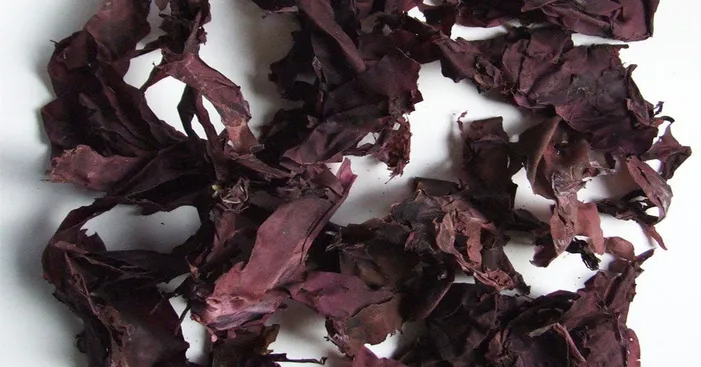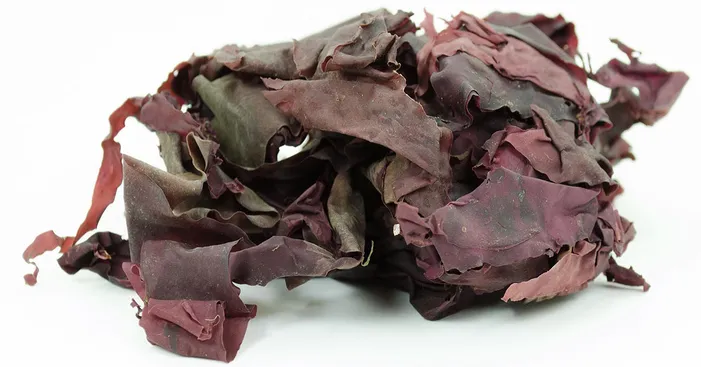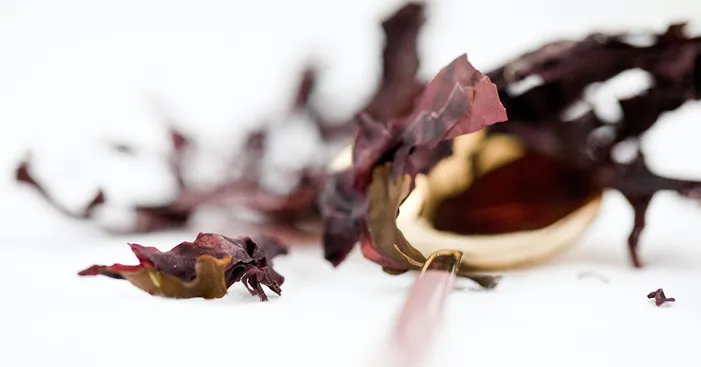Table of Contents

Dulse is a type of seaweed that’s been eaten for centuries, and it lives up to the hype.
It is also a good source of iodine, which is essential for thyroid function.
In addition to its nutritional benefits, dulse is also good for the environment.
It’s a sustainable food source that doesn’t require any land or freshwater to grow.
Dulse can also help to clean up the ocean by absorbing excess nutrients.
If you’re looking for a healthy and sustainable food to add to your diet, dulse is a great option.
It’s easy to find and can be eaten in a variety of ways. You can eat it fresh, dried, or ground into a powder.
Dulse can also be added to soups, stews, salads, and smoothies.
In this blog post, we’ll take a closer look at the many health benefits of dulse and give you some tips on how to add it to your diet.
General facts about dulse:

Overview:
Dulse is a seaweed that grows wild in the cold seas of northern Japan, mainly in Tohoku and Hokkaido.
It is a rare seaweed that only comes into production around December and withers and disappears after March, making mass production very difficult.
Despite its rarity, dulse is a highly sought-after seaweed.
It is known for its unique flavor and its many nutritional benefits.
Dulse is a good source of protein, fiber, vitamins, and minerals.
It is also a natural source of iodine, which is important for thyroid health.
It has a unique crunchy texture and a bright reddish purple color when raw.
The flavor is also similar to nori seaweed, with a slightly smoky undertone.
Dulce grows wild in cold seas, and has been traditionally consumed in Hokkaido, Japan.
However, its use as a food has not progressed as much in Japan as compared to other seaweeds such as kelp and wakame.
However, in recent years, dulce has gained popularity in Scandinavia, Europe, and the USA as a superfood.
It has been introduced in multiple media outlets and is gradually attracting attention in Japan as well.
Dulce is a nutrient-rich food that is especially high in iodine, iron, and vitamin B6.
It is also a good source of calcium, magnesium, and potassium. Dulce can be eaten fresh, dried, or powdered.
It can be added to salads, soups, stews, and smoothies.
It can also be roasted and eaten as a snack.
Different names:

has been known by many different names over the years. In 1753, it was first classified as Fucus palmatus, but in 1801 it was reclassified as Palmaria palmata.
In 1830, Greville further classified the seaweed as Rhodymenia palmata, but this taxonomy was later considered erroneous and the Latin name Palmaria palmata was retained.
Dulse is also known by many different common names.
In North America, it is known as main de mer palmée, rhodyménie palmé, or petit goémon.
In Western Europe and Scandinavia, it is known as cow wrack, cattle wrack, or cow seaweed.
These names allude to the fact that dulse was once used as animal feed when hay was scarce.
The term dulse appeared later, when humans began to consume the seaweed.
The name derives from the adjective “sweet” in Ireland, and was later adopted by the Bretons.
Dulse nutritional values and health benefits:

Nutritional values:
In terms of energy, 100 g of dulse provides around 168 Kcal.
This dulse also contains a significant amount of fiber and trace elements. The breakdown is as follows:
- Dietary fiber or polysaccharides: 28.9 g
- Vitamin c: 84 mg
- Calcium: 411 mg
- Iron: 35.2 mg
- Iodine: 28.9 mg
- Sodium: 1547 mg
- Potassium: 7040 mg
- Magnesium: 222 mg
Macronutrients include 21.8 g carbohydrates, 17.2 g protein and 1.4 g fat.
Health benefits:

Help fights cancer:
In 1981, Dr. Jane Teas of the University of South Carolina made a startling observation: Asian women were much less likely to develop breast cancer than Western women.
The reason? dulse.
Dulse is a staple of the Asian diet, and it is rich in two compounds that have been shown to have powerful anti-cancer properties: iodine and fucoidane
Iodine helps to regulate the thyroid gland, which plays a role in cell growth and metabolism.
Fucoidane is a type of polysaccharide that has been shown to inhibit tumor growth and induce apoptosis (programmed cell death) in cancer cells.
Numerous experimental studies have shown that iodine can inhibit tumor development.
For example, one study found that iodine supplementation reduced the incidence of breast cancer in rats by up to 50%.
Another study found that iodine supplementation reduced the growth of existing breast tumors in mice.
Fucoidane is also a highly promising anti-cancer agent.
Studies have shown that fucoidane can induce apoptosis in a variety of cancer cells, including breast cancer cells, colorectal cancer cells, and leukemia cells.
Fucoidane is also thought to have anti-angiogenic properties, meaning that it can block the formation of new blood vessels that tumors need to grow and spread.
In addition to its anti-cancer properties, dulse is also a good source of other nutrients that are important for health, such as fiber, vitamins, and minerals.
Overall, the evidence suggests that dulse is a powerful weapon against cancer.
If you are looking for a way to reduce your risk of cancer, consider adding dulse to your diet.
Full of antioxidants:
dulse is a nutrient-rich food that is packed with antioxidants.
Antioxidants help to protect our cells from damage caused by free radicals.
Free radicals are unstable molecules that can damage our DNA and cells, leading to premature aging and disease.
dulse contains a variety of antioxidant compounds, including flavonoids, carotenoids, phenolic acids, vitamin E, and vitamin C.
These compounds work together to neutralize free radicals and protect our cells from damage.
Reduce cholesterol levels:
Dulse is a great way to reduce LDL (“bad”) cholesterol levels. It’s packed with phytosterols, which are plant compounds that mimic the structure of cholesterol.
This “fools” the body into absorbing less cholesterol from the diet.
Dulse also has other properties that can help prevent cardiovascular disease.
For example, it’s a good source of fiber, which can help lower cholesterol levels and improve blood sugar control.
So if you’re looking for a way to boost your heart health, consider adding some dried dulse to your diet.
It’s a delicious and nutritious way to reduce your risk of cardiovascular disease.
A powerhouse of nutrients:
Dulse is a nutrient-dense food that is packed with vitamins, minerals, and antioxidants.
It is a particularly good source of iodine, which is essential for thyroid function.
it also contains selenium, iron, calcium, copper, zinc, magnesium, manganese, phosphorus, and vitamins A, B9, C, and B5.
Vitamin K is especially noteworthy, as it plays a vital role in blood coagulation.
Dulse is also a good source of vitamin B12, which is important for vegetarians and vegans.
Precautions before you consume dulse:

Although considered healthy, there are a number of precautions to be taken when consuming dulse seaweed.
For example, in the case of a thyroid gland problem, it is advisable to consult a specialist before including it in the diet.
Sometimes this can be beneficial and necessary, but in other cases it will generate imbalances in the functioning of the gland that will have no positive impact on the state of health.
Micronutrient intake should be optimized in cases of impaired thyroid function.
On the other hand, it is essential to ensure that dulse seaweed is organically grown.
Sometimes, these foods can contain large quantities of heavy metals, which can lead to health problems over time.
However, it’s not for everyone.
Pregnant or breastfeeding women, people with thyroid problems, high blood pressure, or metabolic disorders should avoid it.
Individuals with seafood allergies should also be careful.
If you’re thinking about taking dulse, talk to your doctor first.
Overdosing can cause side effects like irritability, tremors, and diarrhea.
Using dulse:

Dulce is a nutritious and healthy food that is becoming increasingly popular both domestically and internationally.
While it is not yet well-known, the natural food and cosmetics industries have already begun to manufacture products that take advantage of its high efficacy.
One company, Soiree International, has begun making cosmetics using the beauty effects of dulce.
Their dulce-based beauty creams and lotions are currently sold mainly to beauty salons.
Dulce is a superfood that is rich in vitamins, minerals, and other beneficial nutrients.
It is also a good source of protein and fiber.
Due to its high nutritional value, dulce is often consumed by people who are dieting or trying to maintain a healthy lifestyle.
In addition to its nutritional benefits, dulce is also believed to have beauty benefits.
For example, it is said to help improve skin elasticity and reduce the appearance of wrinkles.
Dulce is a versatile ingredient that can be used in a variety of ways.
It can be eaten on its own, added to smoothies or other beverages, or used in cooking.
It can also be used to make cosmetics, such as beauty creams and lotions.
Dulse is a red dulse with a full-bodied yet mild flavor and a hint of iodine.
It can be used to make both sweet and savory dishes, both raw and cooked, both hot and cold. Here are a few ideas:
- Vegetable crumble with dulse and buckwheat: A hearty and flavorful main course or side dish.
- Pear tartar with dulse: A unique and refreshing dish that combines the sweetness of pears with the salty and umami flavors of dulse.
- Mixed salad with dulse: A simple but delicious way to add a bit of extra nutrition and flavor to your salad.
- Dulse chips: A healthy and tasty snack or appetizer.
- Penne gratin with parmesan and dulse: A cheesy and flavorful pasta dish.
- Sesame seed cookies with dulse: A sweet and salty treat that is sure to please.
